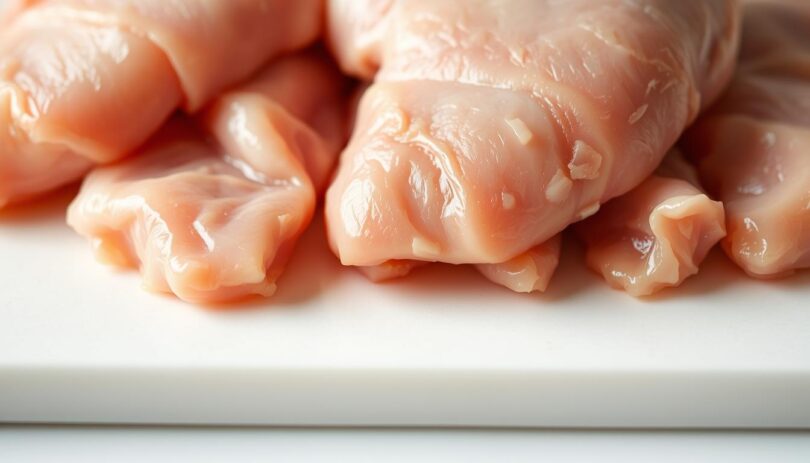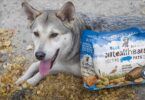What if a popular pet food trend could do more harm than good? As raw diets gain momentum among health-conscious owners, many wonder whether uncooked poultry aligns with their furry companion’s well-being. This article cuts through the noise to address pressing concerns and clarify misconceptions.
Feeding pets uncooked meat isn’t a new concept, but it demands careful consideration. While some advocates praise its nutritional potential, bacterial risks like salmonella remain a critical talking point. Veterinarians emphasize that safe handling practices and portion control are non-negotiable for minimizing hazards.
This guide explores both sides of the debate using insights from veterinary nutritionists and recent studies. You’ll learn how to evaluate your pet’s unique needs and discover actionable steps to reduce contamination risks. For a deeper dive into safe feeding practices, explore our guide on the safety and benefits of raw diets.
Let’s navigate this complex topic together—because informed choices lead to healthier, happier pets.
Understanding Raw Chicken in a Dog’s Diet
Feeding pets uncooked meat requires balancing potential benefits with critical safety measures. While raw poultry offers nutritional advantages, it also presents challenges that demand careful evaluation. Let’s explore how this protein source fits into modern feeding practices.
Nutritional Benefits of Raw Chicken
Unprocessed poultry provides high-quality protein essential for muscle development and energy. Its amino acid profile supports skin health and immune function. Natural enzymes in uncooked meat may also aid digestion, aligning with ancestral eating patterns.
Some owners report shinier coats and increased vitality after introducing raw food. These outcomes often stem from the absence of preservatives found in processed meals. However, results vary based on individual needs and preparation methods.
Potential Health Risks to Consider
Bacterial contamination remains the primary concern with uncooked poultry. Pathogens like salmonella can affect both pets and households if handling protocols aren’t followed. Vulnerable animals, including puppies or seniors, face higher infection risks.
Improper portion sizes might lead to nutritional imbalances over time. Consulting a veterinarian helps tailor meat intake to your companion’s age, weight, and activity level. Combining variety with other protein sources creates safer meal plans.
Safe Feeding Practices: Can Dogs Have Raw Chicken
Transitioning to uncooked poultry requires strategic planning to protect your pet’s health. Experts recommend a phased approach, starting with small portions mixed into their regular meals. This method helps sensitive stomachs adjust without triggering digestive issues.
Precautions for Transitioning to a Raw Diet
Begin by replacing 10-15% of their current food with fresh protein over 7-10 days. Observe energy levels and stool consistency daily. Sudden changes can disrupt gut balance, so patience is key.
Always handle uncooked ingredients separately using dedicated utensils and surfaces. Freeze meat for 48 hours before serving to reduce bacterial load. Portion sizes should match your companion’s weight and activity—overfeeding strains their system.
Track reactions like itching or lethargy, which may signal intolerance. Regular vet checkups ensure nutritional needs are met long-term. Studies show gradual shifts paired with moderation lower contamination risks significantly.
Combining variety with precise measurements creates safer meal plans. Rotate proteins weekly and supplement with veggies for balanced nutrition. Remember—every animal responds differently, so tailor strategies to their unique needs.
Different Parts of Raw Chicken and Their Benefits
Poultry offers more than just basic nutrition—its various components provide distinct advantages. From muscle-building cuts to collagen-rich connective tissues, each part serves a purpose in supporting overall health. Variety ensures pets receive a spectrum of nutrients while keeping meals engaging.
Chicken Breast, Thighs, and Wings
Breast meat delivers lean protein ideal for active companions. Thighs contain higher fat content and minerals like zinc, supporting skin and coat vitality. Wings supply natural cartilage, which promotes joint flexibility through glucosamine.
Dark meat cuts offer iron and B vitamins for energy production. These nutrients aid metabolism and cellular repair. Combining different cuts creates meals that mirror ancestral diets while meeting modern nutritional standards.
The Importance of Chicken Bones and Feet
Uncooked bones act as natural toothbrushes, reducing plaque and strengthening jaws. They’re rich in calcium and phosphorus for skeletal health. Feet provide chondroitin and collagen, which cushion joints and improve mobility.
Moderation remains crucial—always supervise chewing sessions. Avoid giving weight-bearing bones from larger animals, as these may fracture teeth. Balance bony parts with muscle meat and organs to prevent digestive upset.
Handling and Preparing Raw Chicken for Your Dog
Proper preparation transforms fresh ingredients into safe, nourishing meals. Mastering food safety protocols minimizes risks while preserving nutritional value. Let’s explore methods to keep meals healthy from fridge to bowl.
Proper Thawing and Storage Techniques
Thaw frozen raw dog food in the refrigerator—never at room temperature. This slow process prevents bacterial growth while maintaining texture. For quicker defrosting, seal portions in leak-proof bags and submerge in cold water.
Store fresh food in airtight containers at 40°F or below. Use within 2-3 days of thawing, and label packages with dates. Freezing at 0°F halts pathogen development but doesn’t eliminate existing bacteria.
Choose high-quality sources when buying meat. Reputable suppliers follow strict hygiene standards, reducing contamination risks. Look for USDA-inspected products with clear origin labels.
Clean all surfaces and bowls with hot, soapy water after each meal. Replace worn utensils that harbor germs in scratches. Watch for subtle signs like vomiting or diarrhea—early detection prevents severe illness.
Risks of Bacterial Contamination from Raw Chicken
While raw diets offer potential benefits, unseen dangers lurk in improperly handled poultry. Bacterial contamination remains a top concern for pet owners exploring uncooked meals. Two primary pathogens—Salmonella and Campylobacter—often thrive in fresh meat, posing threats to animal and human health alike.
Identifying Signs of Salmonella Infection
Watch for sudden vomiting, diarrhea, or lethargy after meals. Fever and reduced appetite often signal trouble. Puppies and older companions face higher risks due to weaker immune systems. Contact your vet immediately if these symptoms appear—early treatment prevents complications.
Avoiding Campylobacter and Other Contaminants
Campylobacter spreads through contact with contaminated surfaces or feces. Practice strict hygiene: wash hands thoroughly after handling meat and disinfect preparation areas. Freezing poultry for 72 hours before serving reduces bacterial loads significantly.
Healthy pets can still carry harmful bacteria without showing symptoms. Store raw food separately from human groceries and use dedicated cutting boards. Regular fecal tests help detect silent infections early. Always source meat from reputable suppliers with safety certifications.
Assessing Raw Chicken Diets Versus Cooked Alternatives
Pet owners often face a nutritional crossroads when choosing between fresh and heat-treated meals. Each approach carries distinct advantages and challenges, requiring thoughtful evaluation of biological needs and lifestyle factors.
Comparing Nutritional Value and Digestibility
Unprocessed poultry retains heat-sensitive nutrients like B vitamins and amino acids that support metabolic functions. Natural enzymes in fresh meat may enhance digestion for some animals, potentially reducing bloating or irregular bowel movements. Cooked options eliminate harmful bacteria but lose up to 30% of certain vitamins during preparation.
Digestibility varies between individuals—some thrive on uncooked protein, while others tolerate baked or boiled versions better. Combining both methods allows owners to balance safety with nutrient density. For example, lightly steaming chicken preserves more vitamins than frying while reducing microbial risks.
A mixed feeding strategy often works best. Rotate fresh meals with gently cooked proteins and fiber-rich vegetables. This approach maintains variety in the bowl while addressing specific health concerns like food sensitivities or weakened immune systems.
Consult a veterinary nutritionist to design meal plans tailored to your companion’s age and activity level. Regular bloodwork helps identify deficiencies or excesses, ensuring their diet evolves with changing needs over time.
Integrating Raw Chicken into a Balanced Dog Diet
Variety forms the foundation of any successful feeding strategy. While fresh poultry offers nutritional value, relying solely on one protein source risks creating gaps in essential nutrients. Thoughtful meal planning ensures companions receive diverse vitamins, minerals, and amino acids.
Building Nutritional Diversity
Rotate proteins weekly—try beef, turkey, or fish alongside poultry. Mix chopped vegetables like spinach or carrots into meals for fiber and antioxidants. Organ meats such as liver provide concentrated nutrients but should constitute only 5-10% of total intake.
Measure portions based on weight and activity level. Active companions might need 2-3% of their body weight daily, split into two meals. Less active pets often thrive on smaller, more frequent feedings to maintain energy balance.
Consult a veterinarian before altering diets significantly. They can recommend supplements like omega-3s or probiotics to address individual needs. Regular checkups help track weight changes and adjust meal plans accordingly.
Structured variety prevents boredom while supporting overall health. Alternate between fresh and gently cooked proteins to balance safety with nutrient retention. This approach keeps tails wagging and bodies thriving.
Final Thoughts on Feeding Dogs Raw Chicken Safely
Balancing nutrition and safety forms the cornerstone of raw feeding practices. Fresh poultry offers high-quality protein and essential nutrients but requires meticulous handling to protect both pets and households. Veterinary guidance helps tailor meal plans to individual needs while minimizing bacterial risks.
Gradual transitions and strict hygiene protocols remain vital for success. Rotate proteins, monitor reactions, and maintain separate prep areas to prevent cross-contamination. Nutritional diversity paired with precise portions supports long-term health without compromising safety.
Every pet responds differently—what works for one animal might not suit another. Regular checkups and professional advice ensure dietary choices align with age, activity level, and medical history. Thoughtful observation helps spot early warning signs before they escalate.
By prioritizing balanced inclusion and expert collaboration, dog owners can navigate raw diets confidently. Informed decisions rooted in science lead to thriving companions and peace of mind. Your dedication to safe practices makes all the difference in their well-being.
FAQ
Is raw chicken safe for canine consumption?
While some pets thrive on raw diets, uncooked poultry carries risks like salmonella exposure. Consult a veterinarian to assess your pet’s needs and ensure proper handling practices. High-quality protein and natural enzymes may offer benefits, but individual health factors matter.
What nutritional advantages does uncooked poultry offer pets?
Fresh, unprocessed chicken provides bioavailable protein, amino acids, and B vitamins. Organs like liver add essential nutrients like iron and vitamin A. Always pair it with other ingredients for a balanced meal plan.
How can owners minimize bacterial exposure when feeding raw poultry?
Freeze meat for 72 hours before serving, use separate prep tools, and clean surfaces with vinegar or pet-safe disinfectants. Source human-grade products from trusted suppliers like Sprouts or Whole Foods to reduce contamination risks.










Leave a Comment